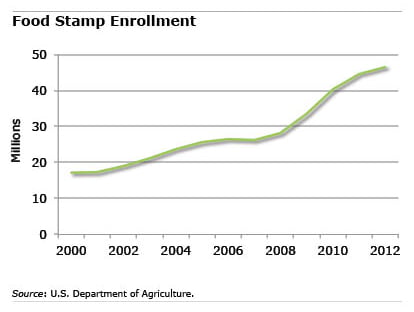
Food Stamps Need Rises in Good Times
Enrollment in the federal food stamp program, known as SNAP – for Supplemental Nutrition Assistance Program – has more than doubled over the past decade to 47 million.
What’s remarkable is that for the first time the number of Americans receiving food stamps increased even in a period when the economy was growing. During the 2003-2007 expansion, the SNAP case load, in a break with historic trends, rose 24 percent.
One explanation is the change in the longstanding correlation between the unemployment rate and poverty, according to research findings by economists Matt Rutledge and April Yanyuan Wu of the Center for Retirement Research, which were presented at the Retirement Research Consortium meeting in August.
Poverty used to fall in tandem with the jobless rate, reducing the need for food stamps. But the researchers found that the mid-2000s expansion was different: poverty did not decline as the economy grew.
In the recovery that has followed the Great Recession, the number of people receiving food stamps continued to rise, according to federal data.
The assumption has always been that a stronger labor market will reduce the need for food stamps. But this new trend suggests rising employment might no longer be enough. Reducing the food stamp rolls may require a broader recovery or initiatives to reduce poverty and provide more jobs for the marginally employed.
Full disclosure: The research cited in this post was funded by a grant from the U.S. Social Security Administration (SSA) through the Retirement Research Consortium, which also funds this blog. The opinions and conclusions expressed do not represent the opinions or policy of SSA or any agency of the federal government.
Comments are closed.








I suspect that one reason this is happening is because they have eased the eligibility requirements for food stamps over recent years – so that more people could qualify – and also made the vouchers easier to use by issuing stored value cards. At the risk of sounding cynical, this has happened largely because the food stamp program, whatever its many virtues, is at the same time yet another politically-motivated subsidy to farmers. Whether the actual need for food stamps has increased can’t be determined from the increase in the number of food stamp recipients. While undoubtedly a lot of people are having a tough time in this jobless recovery, the real need for food stamps may not have increased nearly as much as the number seem to suggest.
Rising employment is not enough when jobs are low wage and the cost of living continues to rise. Many employees who earn a minimum wage need food stamps so they can eat. The ways in which the food stamp program serves as a subsidy to the low wages paid by large corporate employers has been well documented by Barbara Ehrenreich, author of Nickel and Dimed, and others.